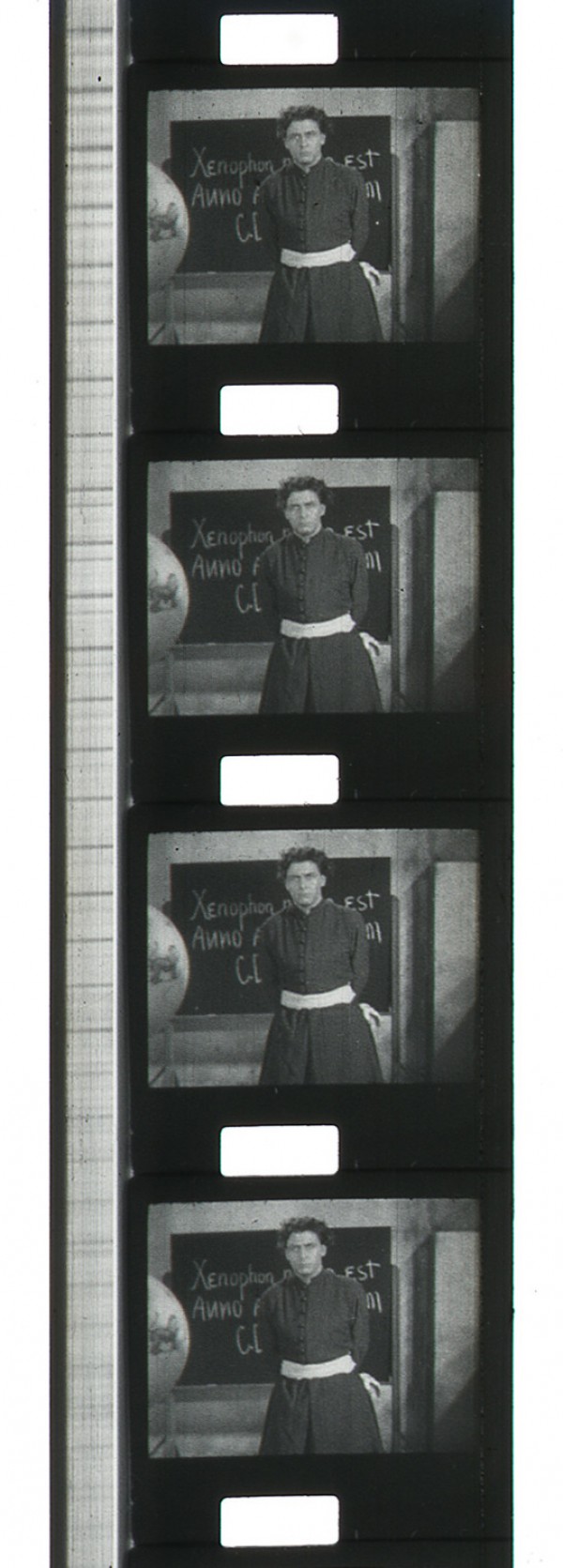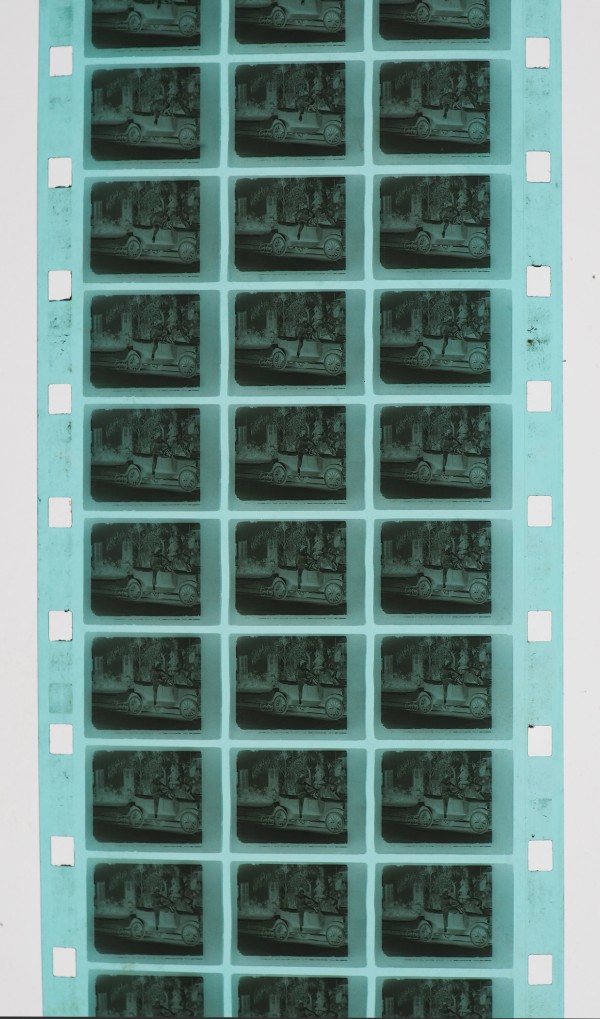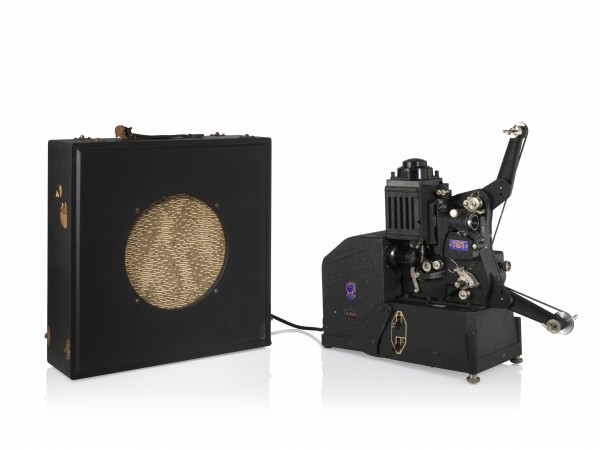Film Explorer

“Pathé 9.5 mm sonore” (“Pathé 9.5mm sound”) logo, with three multi-zone tracks of mono variable-area optical sound.
Fonds Jean-Bonnet, Fondation Jérôme Seydoux-Pathé, Paris, France.

9.5mm reduction print with variable-area optical sound of the documentary La Croisière d’escadre, Pathé-Baby sound release no. 70026, 1937.
Fonds Jean-Bonnet, Fondation Jérôme Seydoux-Pathé, Paris, France

Tarass Boulba (Alexis Granowsky, 1936), Pathé-Baby sound release no. 70135, adapted for small-gauge release c. 1950. 9.5mm reduction print with variable density optical sound.
Fonds Jean-Bonnet, Fondation Jérôme Seydoux-Pathé, Paris, France.

35mm Pathé-Baby printing negative of Beaucitron et plein-de-jus kidnappeurs, Pathé-Baby release no. 80014. Adapted for sound in 1939 from No Kidding (James Davis, 1928). This is an example of a film that was originally silent, but was released with an added soundtrack in 9.5mm. Note that a portion of the image is cropped to leave room for adding the optical soundtrack after printing.
Fondation Jérôme Seydoux-Pathé, Paris, France
Identification
These were printed on special 35mm Pathé-Baby film, then slit into 9.5mm prints.
6.85mm x 5mm (0.27 in x 0.2 in).
Approximately. There was some variation in aspect ratios.
A central rectangular perforation (2.4 mm x 1 mm) in between each frame.
Positive Pathé, B/W.
None
1
Pathé 9.5 mm sonore
The optical soundtrack was 1.15mm (0.05 in) wide and was printed on the left edge of the film. Variable-area tracks were most commonly used, however some releases utilized variable density. Before 1945, the offset between sound and image was 25 frames; after 1945 the offset was 28 frames.
9.5mm reduction prints were sourced from 35mm productions. They were prepared in rows of three on special 35mm printing elements with non-standard “working perforations” (referred to as “perforation de travail” in French).
7.2mm x 5.23mm (0.28 in x 0.21 in) in three rows on 35mm film. Some prints sourced from silent aperture films have the frame dimensions 7.2mm x 6mm (0.28 in x 0.24 in).
Non-standard “working perforations” (“perforation de travail”) on 35mm film with the dimensions 1.6mm (width) x 2mm (height).
History
The widespread use of sound in cinema in the early 1930s naturally led the main industrial players in amateur cinema to extend the innovation to smaller formats. After extensive research, which began in 1933, the Pathé company launched 9.5mm sound prints along with the Pathé-Vox projector in March 1937. The new projector enabled the showing of 9.5mm reduction prints, with optical sound printed on the left edge of film.
The photographic reduction of optical tracks from 35mm posed major technical challenges for the two Pathé engineers entrusted with this task: Léopold Lobel and Georges Boulot. In order to respect the original aspect ratio of standard format images, the optical track from the source 35mm film was reduced in the same proportions as the image. With a reduction factor of 2.5, the optical track would measure just 1mm across in 9.5mm. This meant that the image size on the 9.5mm print would only be slightly reduced. However, such a narrow optical track raised a number of reproduction issues, including the necessity for the finest possible emulsion granulation, in order to best capture microscopic-scale light variations. There was also the difference in running speed between 35mm and 9.5mm (at the same recording rate of 24 frames per second) to be considered, which made re-recording even more complex – especially for high-pitched sounds of frequencies above 4,000 Hz.
It was the addition of sound on 17.5mm Pathé-Rural films that paved the way for 9.5mm sound. The problems were solved in 1932 thanks to Henri Chrétien's patents on anamorphosis, which were employed on the 17.5mm format to compress the length of sound tracks. In February 1934, the magazine Ciné-amateur published, exclusively and with photos, the successful optical transfer of a 35mm sound negative onto 9.5mm. This was followed by three years of research to design the Pathé-Vox projector and an industrial method for manufacturing sound copies.
Until 1957, 35mm sound films were regularly released in 9.5mm versions, mainly in French and English. Film historians Patrick Moules, Garth Pedler and David Wyatt have documented over 500 titles that were made available for the non-theatrical market. Some silent films were reissued in sound, with the addition of musical accompaniment. Sound films adapted to Pathé-Baby, in silent or sound versions, continued to be reedited and shortened, but to a lesser extent than silent films.
The sound projectors produced by Pathé and other manufacturers could project both sound and silent films. To achieve this, they were equipped with a dual frame rate, 16 and 24 fps, and projection masking that hid the soundtrack if necessary. Because of their high price, these machines were mainly intended for schools, universities, film clubs and wealthy consumers.
Selected Filmography
Pathé-Baby sound release no. 70000, April 1937.
Pathé-Baby sound release no. 70000, April 1937.
Pathé-Baby sound release no. 70077, October 1938.
Pathé-Baby sound release no. 70077, October 1938.
Pathéscope sound release no. 9514, December 1939.
Pathéscope sound release no. 9514, December 1939.
Pathé-Baby sound release no. 70026, September 1937.
Pathé-Baby sound release no. 70026, September 1937.
Pathéscope sound release no. 9686, April 1951.
Pathéscope sound release no. 9686, April 1951.
Pathé-Baby sound release no. 70155, Frimousset passe une nuit blanche.
Pathé-Baby sound release no. 70155, Frimousset passe une nuit blanche.
Pathé-Baby sound release no. 70213, April 1957.
Pathé-Baby sound release no. 70213, April 1957.
Pathé-Baby sound release no. 70132.
Pathé-Baby sound release no. 70132.
Pathé-Baby sound release no. 80014, Beaucitron et plein de jus Kidnappers, 1939.
Pathé-Baby sound release no. 80014, Beaucitron et plein de jus Kidnappers, 1939.
Pathé-Baby sound release no. 70135.
Pathé-Baby sound release no. 70135.
Technology
The optical track reduction process for the 9.5mm format remains somewhat obscure and poorly understood to this day. Patented by Henri Chrétien, a special continuous optical printer with an anamorphic optical unit compressed the source 35mm sound negative in width and length. This was then multiplied three times and printed in rows on specially perforated 35mm Pathé-Baby film. To avoid multiplying the intermediate elements of the sound tracks, which would have compromised the quality of the optical transfer, reduction of these tracks had to be carried out directly on the 35mm Pathé-Baby copies, before cutting them into three strips to make the 9.5mm prints. The 35mm Pathé-Baby internegative sound copies indicate the positioning of the future optical track next to the image, either slightly truncated or reduced to the ratio of the 35mm Academy sound standard.
All types of optical track were claimed to be feasible. However, it seems that optical sound with variable-area tracks was the most widely used, probably because its higher contrast made it more easily readable by the projector’s sound reader. Sound projectors were generally equipped with the reading system based on a slit projected onto the track. This raises the question of whether track de-anamorphosis was necessary, and if so, how it was achieved in the projectors.

Left: This 35mm print of The Flop House (1932) was the source of all 9.5mm prints.
Right: The 35mm internegative of the variable area soundtrack before reduction to 9.5mm. This film was released on 9.5mm under the title Frimousset passe une nuit blanche. It is worth noting that the optical track, originally with variable density, was re-recorded to a variable-area track for the 9.5mm version.
Fondation Jérôme Seydoux-Pathé, Paris, France.

35mm Pathé-Baby printing negative on duplicating film of Frimousset passe une nuit blanche, Pathé-Baby release no. 70155, adapted from The Flop House (Dick Huemer, 1932). This is an example of an original 35mm sound film adapted to 9.5mm with sound.
Fondation Jérôme Seydoux-Pathé, Paris, France.
References
Anon. (1934).Ciné-amateur, 33 (February): p. 19.
Gourdet-Marès, Anne; Shahmiri, Elvira. 2022. Pathé-Baby. Le Cinéma chez soi. Paris: Fondation Jerôme Seydoux-Pathé.
McKee, Gerald (1989). The Home Cinema: A History and Review of the Projectors that Brought Movies into the Home in the 20s and 30s. Gerrards Cross, UK: Privately published.
Moules, Patrick (2020). The 9.5mm Vintage Film Encyclopedia. Market Harborough, UK: Matador.
Pierron, Lucien (1937). “Le film sonore “Pathé-Baby””. Le cinéma chez soi, 103, (June–July): pp. 4–5.
Shahmiri, Elvira. 2022. Une histoire des formats réduits Pathé en France, 1912-1939. Ph.D. dissertation, Université Paris Panthéon Sorbonne. (May 2022).
Vivié, Jean (1936). “Le projecteur Pathé-Vox 9,5”. Ciné-amateur, 67, (December): pp. 45–46.
Patents
Chrétien, Henri, Tireuse à mouvement continu pour pellicules cinématographiques. French patent FR765154, filed February 24, 1933 and issued June 14, 1934.
Preceded by
Followed by
Related entries
Author
After studying history, Anne Gourdet-Marès worked as a projectionist and camera assistant. With a passion for the history of cinematographic techniques, she is in charge of the cinematographic equipment collection at the Jérôme Seydoux-Pathé Foundation. Her research on the history of cameras, and their support, has been the subject of several papers and publications. As a court-appointed expert in her field, she is often consulted on technical issues. She also creates magic lantern shows and educational workshops exploring the technical inventions of cinema. In 2018, she published Si on allait au cinéma! for young audiences, published by À dos d'âne. To mark the centenary of Pathé-Baby, she curated the exhibition “Pathé-Baby: le cinéma chez soi”, held at the Fondation Jérôme Seydoux-Pathé in 2022.
Gourdet-Marès, Anne (2024). “9.5mm reduction prints with optical sound”. In James Layton (ed.), Film Atlas. www.filmatlas.com. Brussels: International Federation of Film Archives / Rochester, NY: George Eastman Museum.
Margaux Chalançon



